Champaner Pavagadh Archaeological Park – I visited this archaeological Park as a part of my trip to explore the ancient stepwells of Gujarat like Rani Ki Vav, Modhera Sun Temple Kund and Adalaj vav in Gandhinagar.
The only knowledge I had before coming here was a documentary which I saw at Epic channel. It was about the life of Khichi Rajputs, who ruled Champaner for two centuries and then lost it to the Sultan Mahmud Begada, the same guy who finished the work of Adalaj Vav.
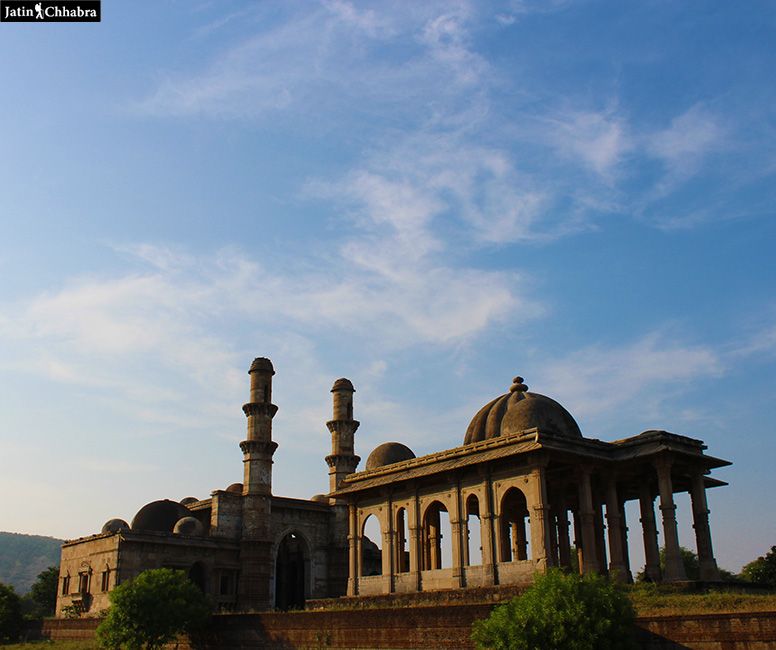
Champaner Pavagadh Archaeological Park
As per my experience of visiting Archaeological Parks, one needs at least 4-5 hours and must have some prior knowledge of the history connected with the site.
So before I share all the artistic sites of Champaner Pavagadh Archaeological Park, I have mentioned some historical events below, linked to this forgotten city, which will make you more interested in plan a tour of Champaner-Pavagadh near Vadodara.
I used the term “Forgotten City” above & in the title because from 17th to 19th century, this whole Archaeological Park was ripped off from Indian history.
Later in mid 19th century, this park was re-discovered by British archaeologists. More on that below in this post.
Devastating history of Champaner Pavagadh Archaeological Park
Champaner, a city, built by Vanraj Chavda in 8th century AD, which he named after his friend & military general Champaraj.
In the 12th century, Prithviraj Chauhan’s (a famous ruler of Rajasthan & New Delhi) kingdom was shattering & many of his Rajput relatives moved in regions like Bundi, Kota, and Champaner (Gujarat).

Prithviraj Chauhan Statue in Ajmer, Rajasthan.
These Rajputs (Khichi Chauhan), fought many battles against local tribes and built a fort in Pavagarh, a hilly region of Champaner.
From 11th to 15th century, Gujarat came under the control of Sultans of Delhi & later their governors, declared themselves independent ruler of Gujarat.
The most famous one was Ahmed Shah who built the city of Ahmedabad.

Delhi Sultanate
Ahmed Shah’s grandson, Mahmud Begada, came to the throne in mid 15th century and started a 20-month long military operation to capture Pavagarh fort from Khichi Rajputs.
At that time Champaner was under the rule of Raval Jaisingh who fought bravely but was captured & later killed as he refused to convert to Islam.
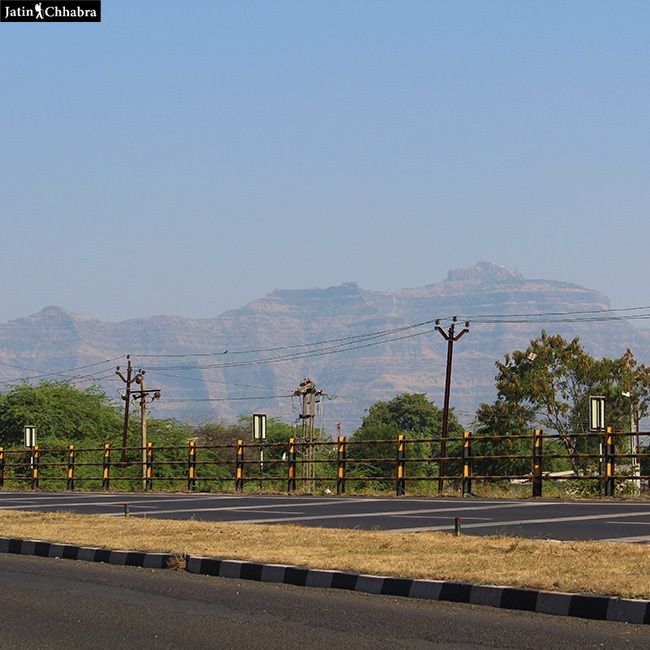
Pavagarh Hill View from Highway
After this victory, Mahmud Begada constructed a new capital in Champaner – Mahemdabad. But this new capital didn’t survive even a century.
In 1535 AD, Champaner was raided by Mughal king Humayun & because of those battles with Mughals, the new Sultan Gujarat left Champaner & shifted his capital back to Ahmedabad. And with this Champaner and Pavagarh were lost in the sand of time.
300 years later Britishers founded the ruins of Champaner-Pavagadh Empire & by 1879 AD, restoration work started.
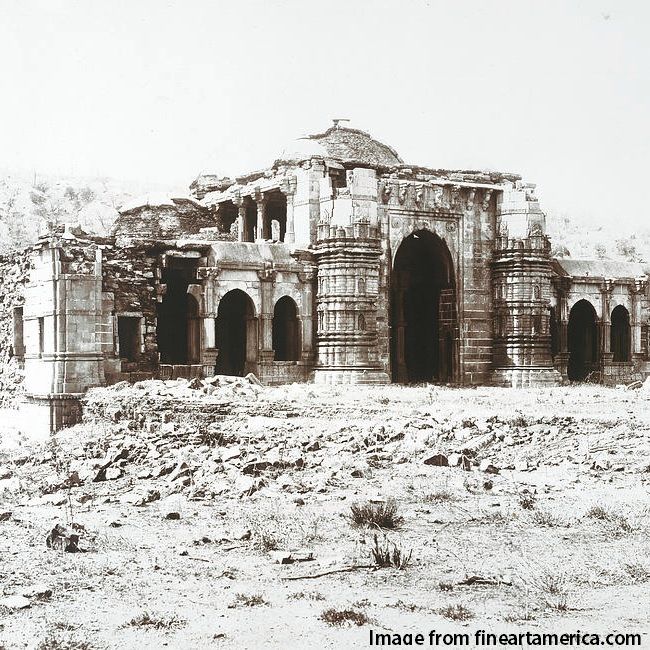
Orignal snap from 19th century Champaner
In 2004, Champaner Pavagadh Archaeological Park was added to the list of protected UNESCO world heritage sites as it has many sandstone mosques, cenotaph and also an ancient Hindu temple of Goddess Kali – Shree Mahakali Temple.
Breathtaking tour of Champaner Pavagadh Archaeological Park:
We reached Champaner Pavagadh Archaeological Park from Ahmadabad via Vadodara Expressway (one of the best roads I have seen in India) and then a left turn before Vadodara city towards Pavagadh.
From here Champaner is just 50 km. The first site where we stopped was the Helical Vav or Helical Stepwell.
Helical Vav or Helical Stepwell:

Helical Vav Entrance
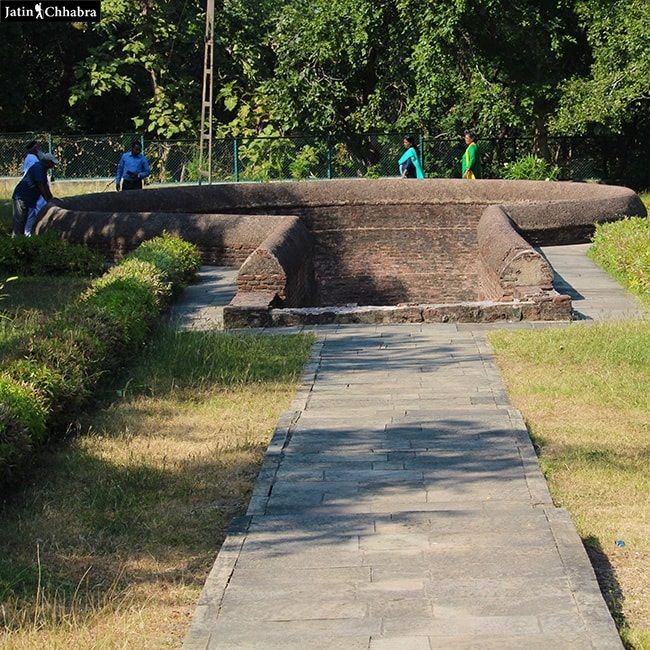
Helical Vav

Helical Vav Well
I had plans to get the pictures of this Stepwell for my collection, and it was because of this Vav, I came to know about Champaner Pavagadh Archaeological Park.
Helical Vav is a 16th-century Stepwell but not as decorated as Adalaj Vav & Rani Ki Vav. For me it was a must visit site as I had to take pictures from my collection of Ancient Stepwells in India.
Entering the Archaeological Park from City Gate “Shari Darwaja”
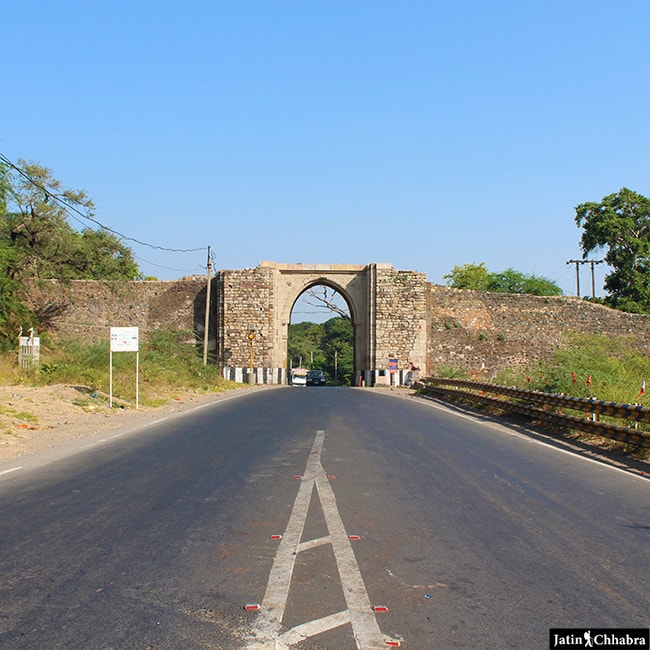
City Gate
From Helical Vav Stepwell, the first site we saw was a centuries old gate which is also the entry point of the Champaner, Its called as “The City Gate: or “Shari Darwaja.”
Sahar ki Masjid

Shaher Ki Masjid
The second site in the Archaeological Park is Sahar ki Masjid.
Sahar ki Masjid was a private mosque of the Sultan & the design of the mosque is unique to what I have seen in other famous mosques of New Delhi or Hyderabad.
This mosque has five mehrabs, an arched doorway, and two tall watch towers. Sadly I was not allowed to take the camera inside, so I took pictures from outside of this complex.
Jami Masjid and a Stepwell
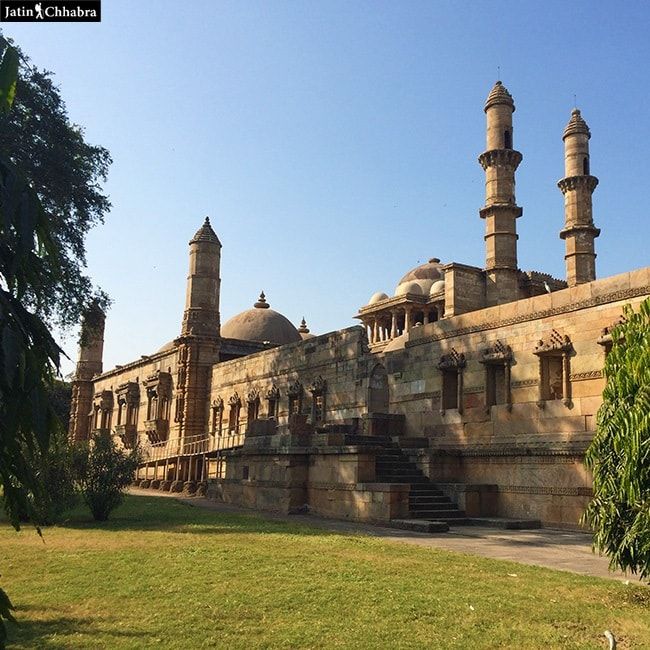
Jami Masjid

Jami Masjid Mosque
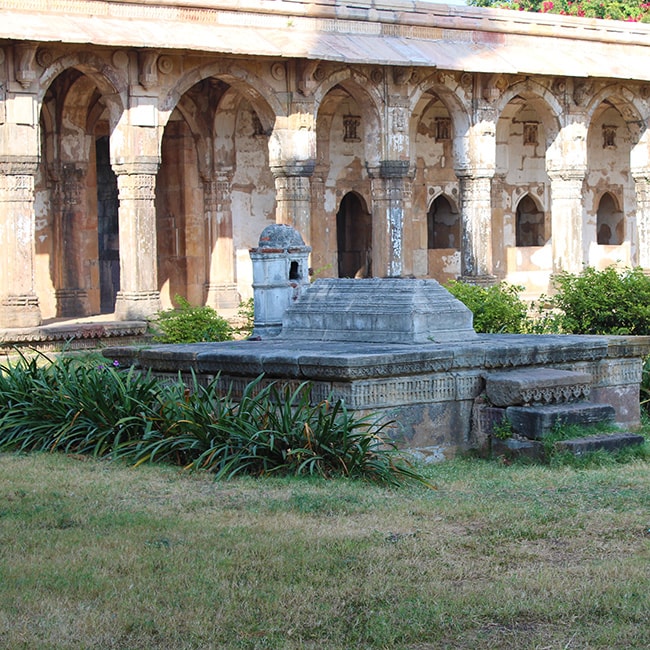
Tomb of a Pir at Jami Masjid
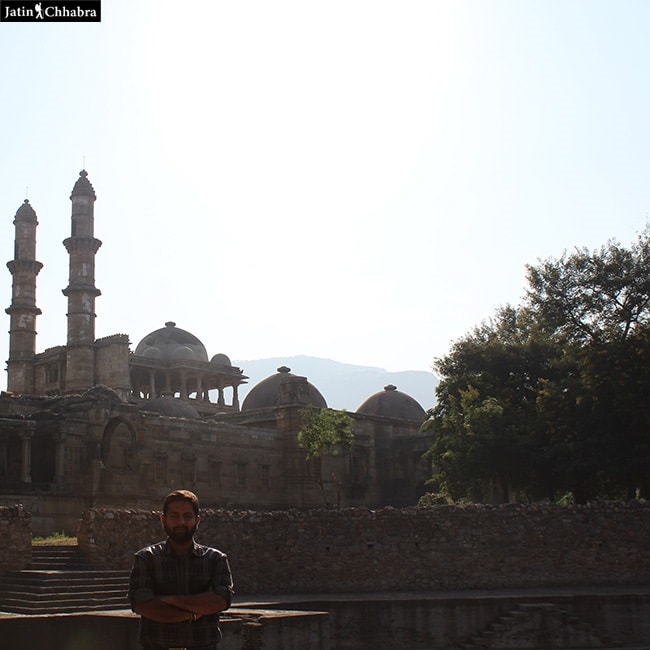
Me at Jami Masjid Stepwell
Jami Masjid and its Stepwell is by far one of the biggest and beautiful site of Champaner Pavagadh Archaeological Park. Built in 1516 AD, Jami Masjid was a popular shrine of a pir, whose tomb is still inside this mosque compound.
Just behind the mosque complex, there is a big stepwell tank which I believe that it was made for pilgrims who use to come here for prayers.
Kevda Masjid

Kevada Masjid
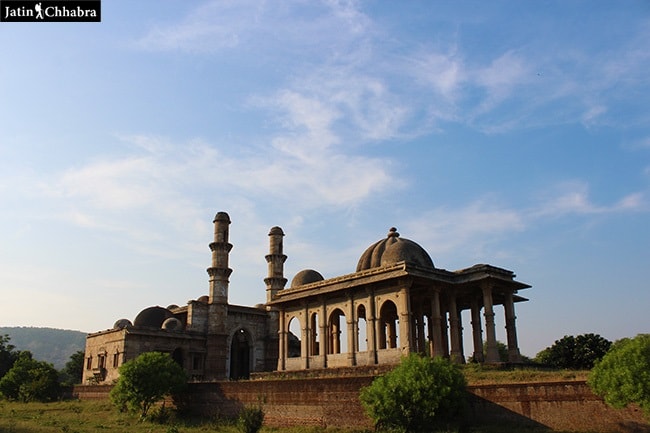
Kevda Masjid and cenotaph
Just a km from Jami Masjid, a narrow road took us to two more beautiful sites & the closest one was Kevda Masjid.
The main attraction here is not the mosque but the Roman style cenotaph which is in front of the mosque.
There is no entry ticket for Kevda Masjid & the view of cenotaph is simply amazing, especially at sunset or sunrise. As per me, Kevda Masjid is the best place to grab some ever lasting pictures for any photographer collection.
Nagina Masjid
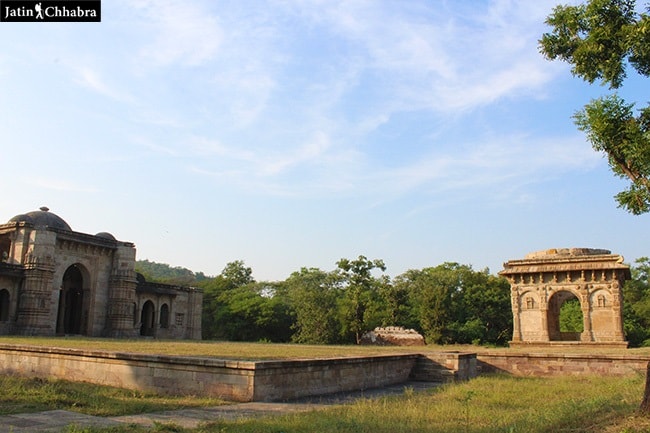
Nagina Masjid
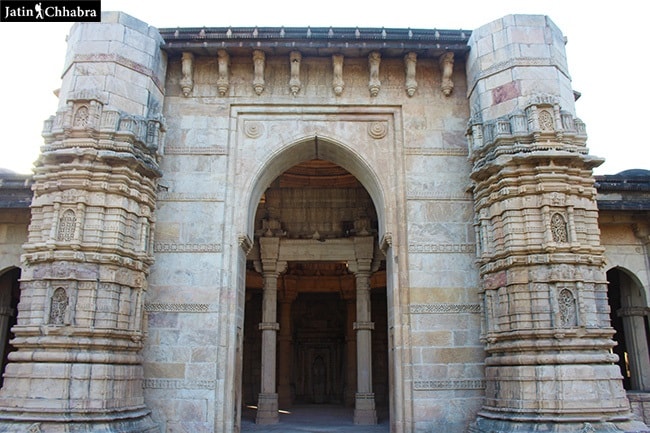
Nagina Masjid Mosque Gate

Inside view of Nagina Masjid Mosque
The last site which we visited in Champaner Pavagadh Archaeological Park was Nagina Masjid.
Nagina Mosque is just 1/2 km from Kenda Masjid and is in the more remote area of the park. At this mosque, I found this beautiful four wall cenotaph, which is not the part of the mosque but is just stunning.

Nagina Masjid Cenotaph

Nagina Masjid Cenotaph Artwork
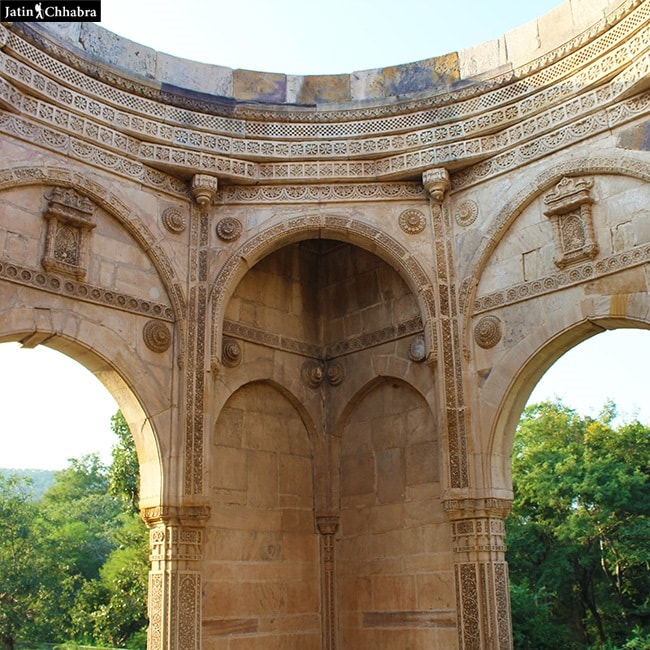
Artwork of Cenotaph at Nagina Masjid
This cenotaph is 50-60 feet tall, and the artwork done on its wall is one of the best Islamic architecture one can find in India.
And with this our tour of Champaner Pavagadh Archaeological Park was finished. It took us hours and I did grab some amazing pictures & knowledge which I have shared here :)
Plus at Chanpaner, there is a famous Hindu shrine of Goddess Kali. So at around 4:30 PM, we decided to visit the Kali temple as everyone back in Ahmedabad suggested us to visit this temple.
The Shree Mahakali Temple at Pavagadh hill
The shrine of Vaishno Devi in J&K is very popular among people in Northern India, and likewise, for many locals living in Gujarat, the Shree Mahakali Temple on top of Pavagadh hill is as famous as Vaishno Devi.
To reach the temple, one can either walk a 5-6 km mountain track or book a ride in a trolley ropeway which cost like Rs 100. We opted the second option.
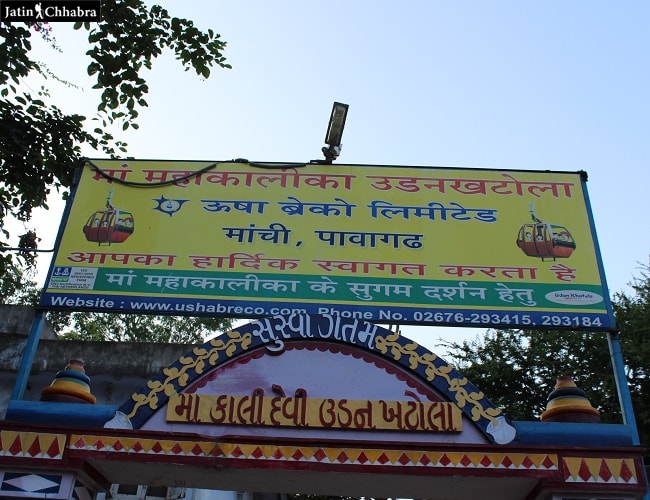
Ropeway for Shree Mahakali Temple
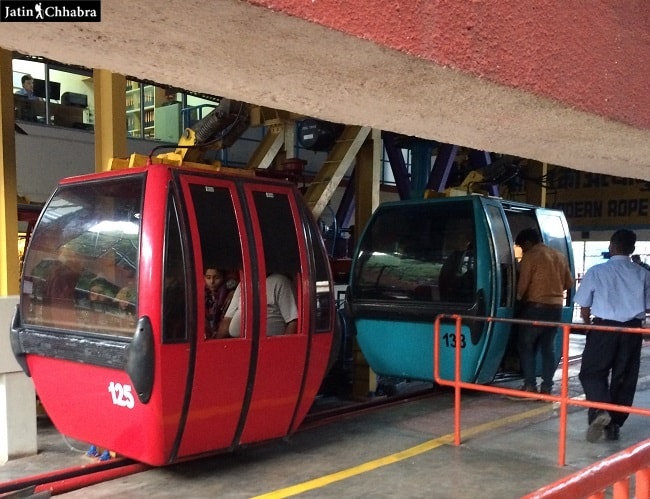
Ropeway for Shree Mahakali Temple
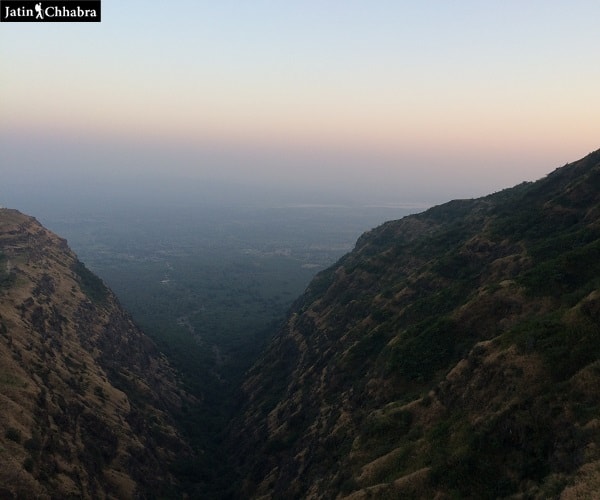
View from Ropeway
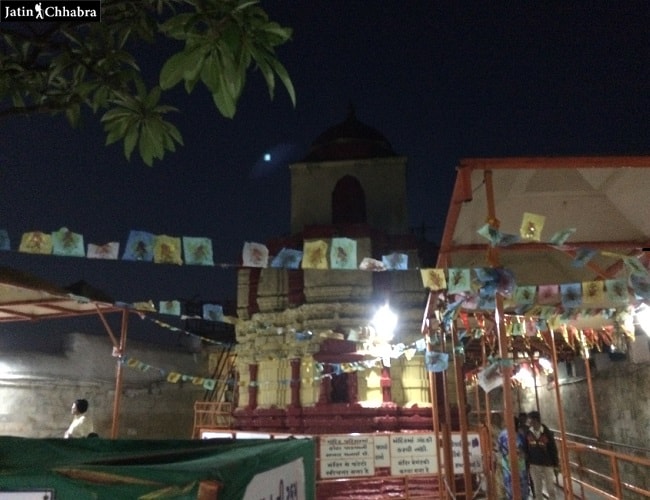
Shree Mahakali Temple Pavagadh (Phone pic)
There was a small line at the ropeway, and it took us 30-40 minutes to reach the peak.
Even after reaching the hilltop, we had to walk 2-3 km and 100-200 steps and an hour to finally arrive at the temple. We weren’t clearly not prepared to walk this much :)
But nevertheless, all tiredness was dissolved once we reached the main temple. I was not allowed to take pictures inside the temple complex where there is a statue of Goddess Kali’s face (nothing that I have ever seen in whole India)
Back to Vadodara
I never planned to visit the Kali temple at Pavagarh hill, but end up giving 3 hours to get the Goddess blessings. By 8:00 PM we came back to the temple parking via ropeway and drove back to Vadodara city which is 40 km from Chamapaner.
Anther thing which I still reminisce about this day was the dinner at a 3-star hotel which serves this delicious Gujarati Thali & at so damn cheap rates. Name of the restaurant is Mandap The Authentic Gujarati Thali Restaurant and here are some shots.
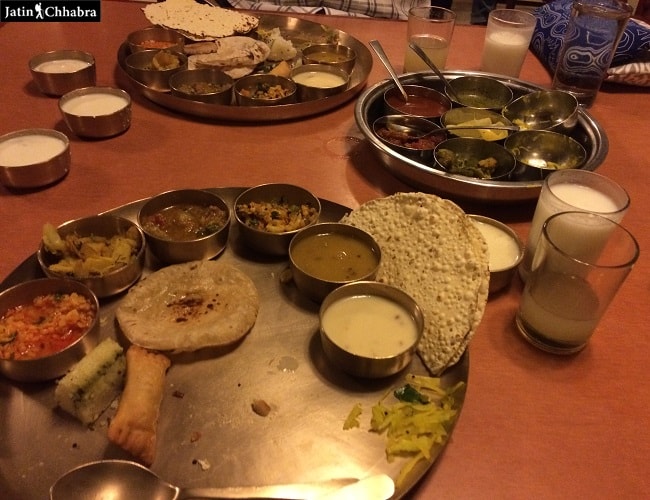
Gujarati Thali at Mandap restaurant
If you are ever planning to visit Champaner Pavagadh Archaeological Park, I would suggest reaching here by 10:00 AM as there is so much to see in the park, and also hire a guide.
The Kali temple is also very famous & if you can, spare three hours to visit this temple to experience the authentic culture of Gujarati people which isn’t visible in cities like Vadodara and Ahmedabad.
After this, I spend a half day in Ahmedabad (around 8 hours), before catching a 8:00 PM flight back to New Delhi.
Planning to visit Champaner-Pavagadh
So, if you are ever planning to visit Champaner, do choose winter months and prefer to land at Vadodara, not Ahmedabad. As Ahmedabad is 150 km away and Vadodara is just 50 km.
Though all other popular sites like Adalaj Vav, Modhera sun temple & Rani Ki Vav are close from Ahmedabad. So do some research on geography before booking at tickets or hotels.



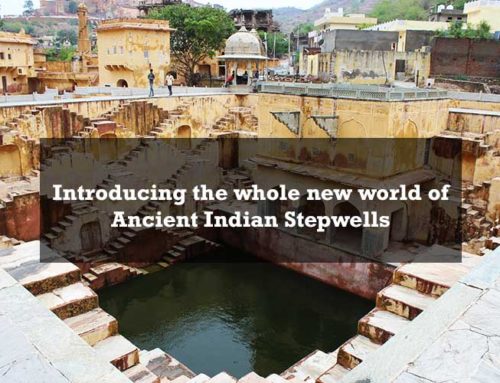

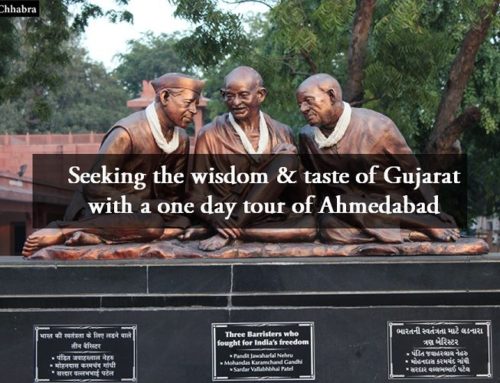

I have been to about 50 countries, and I still need to explore India! Thank you for sharing – the country has been high on my list to visit, and this post only add the desire to do so, sooner than later. Your food photo is absolutely mouth watering – I would like to have those crispy bread and all of the strong curry dish on the plate!
Thanks Halef, do give at least 6 months to India, as its more of a continent that a nation :)
I have heard the name of Champaner and that’s it. Didn’t know it offered so much to explore. The stepwell, the architecture and the food! What else does one need? :)
Thanks Nisha, I would say more maintenance by our government :)
I have been many times in India but to be honest never heard about Champaner place, looks great so I need to explore in the future. All the time I see pictures of Indian food like your I just wish can be there and eat more and more these food, it is so delicious. I love old constructions and India it’s so rich in that, from this place I can see that Jami Masjid Mosque is so beautiful. I want to spend a lot more in India.
Hey Fabia, Jami Mosque is that main attraction here and yeah, the food in this part of India is amazing and surprisingly cheap.
I’d love to try the Ropeway out, it looks like there are many photo opportunities on the way up and at the top. There is so much history to Rajasthan, it’s good to read about a country with decent history! Your photos show off the places very well.
Yeah there is so much to see here but it’s in Gujarat, not Rajasthan :)
I can see why you say you’d need 4-5 hours here! There is so much to see and learn about, from gates to statues to mosques. And the food looks delicious too! I hope to visit this part of the world some day soon.
A full day is a must to completely explore the park. Plus if you are planning to visit India then prefer winter months.
This was really interesting to read about the history behind the park, and I love all your pictures! The structures look so intricately designed, it’s really incredible. I’ve been to India a few times now but not yet Gujarat, although I really would love to visit some day! I shall have to put Champaner Pavagadh Archaeological Park on my list of places to go when I do get there!
Thanks Rhiannon, Gujarat is worth exploring. Plus do check sites like Rani Ki Vav in Patan Gujarat.
I had never heard about this heritage site before. It was for the first time I was reading about. However, the names are quite similar to the ones you find in Mughal empire buildings. Interesting post.
The kingdom was made by the governs of Delhi Sultanate and was completely destroyed by 1st Mughal King Babar. If it wasn’t for ASI (one which was under British rule) we wouldn’t have any info about Champaner.
Thanks for such a.nice description ,it is very helpful in planning the trip ,.can u suggest aplace to stay nearby ,
Thanks Sushma. You can visit Vadodara which is quite close from Pavagadh. Along with the park there is also a temple which require some hiking tour, or trolley is also available, which is Kalika Mata Temple. But tour of Vadodara for a day, like its palace, is a good option.
Thanks for such an informative article.
I’m looking for a local guide who can give half day tour of Champaner in English. I’ll appreciate your suggestions. Thanks very much.
Vikas
Hey Vikas, would suggest to contact travel agencies in Vadodara as its the closest city from Champaner.